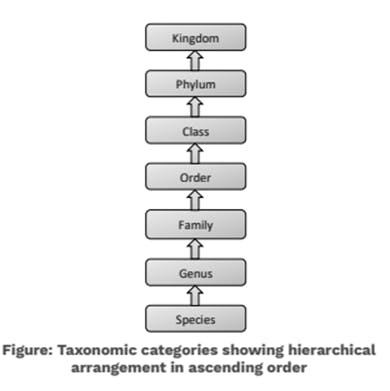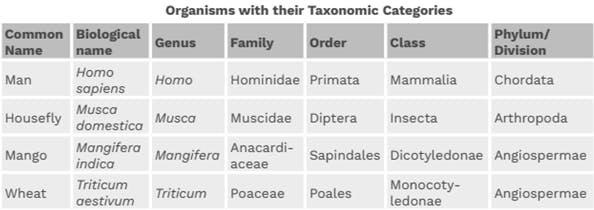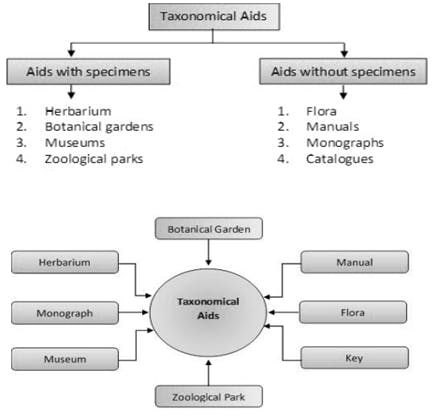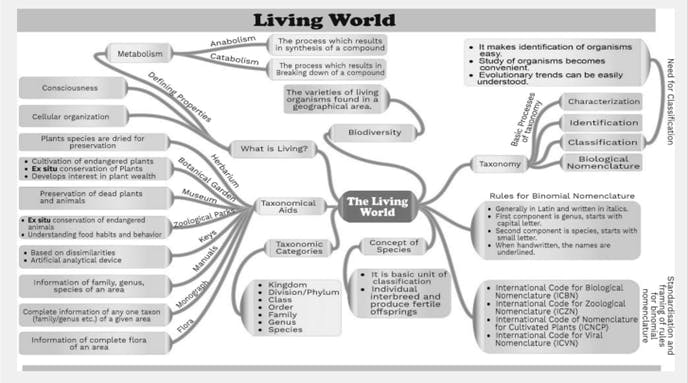
Life is a unique process that is made from the aggregation of molecules. These molecules undergo various chemical reactions to perform their specific functions which are called metabolism. This results in the production and utilization of energy. The metabolism will result in the growth, development, reproduction, adaptations, etc of the living organisms through the production of various biomolecules.
Life is a unique, complex organisation of molecules expressing itself through chemical reactions (metabolism) reproduction. Hence, ‘the object by itself exhibiting the growth, reproduction, consciousness, and other life processes, etc. and show independent existence in nature is designated as living being’.
All the living beings share certain unique and basic characteristics which set them apart from non-living objects. Some of these characteristics are listed below:
Growth
Reproduction
Metabolism
Cellular organization
Consciousness
(1) Growth: All living organisms can undergo the process of growth and development that results in an increase in the mass and number of cells. Multicellular organisms grow by cell division. The growth of plants and animals takes place with the help of cell division. In the case of plants, the cell division occurs throughout their life while in the case of animals the cell division occurs up to a certain age, and then the cells lose their capability to divide.
It results in an increase in body mass and increases in the number of cells.
Examples: Mountains, boulders, sand mounds, etc grow by the accumulation of the materials although they are non-living. So, growth cannot be taken as the factor which categorizes the organism as living.
(2) Metabolism: As the body and organs are the constituents of different chemicals, they perform various metabolic functions that result in the conversion of chemicals into other biomolecules. All plants, animals, and microbes exhibit metabolism. It is absent in the case of non-living organisms but may be introduced through the in-vitro method.
(3) Sensitivity: The living organisms whether prokaryotes or eukaryotes respond according to their surroundings and the stimuli present around them, it may be physical, chemical, or biological. The living organisms are sensitive about their surroundings and are responsible in accordance with their stimuli. The stimuli can either be biological, physical, or chemical.
(4) Reproduction: The ability to produce young ones is the process of reproduction which is observed only in the case of the living organisms. In the case of fungi, reproduction occurs through asexual spores, while in the case of hydra budding occurs and in planaria regeneration occurs which are all the asexual methods of reproduction. Reproduction is the increase in the number of cells while in the case of mules, infertile human couples, etc reproduction is absent. So, reproduction is simply synonymous with growth which is not appropriate to distinguish the living organisms.
(5) Cellular Organization : It is the defining characteristic of living organisms since all living organisms are made up of cells that help in performing various cellular functions resulting in the growth and development, reproduction, metabolism, etc in the body. Since non-living organisms are not made up of cells so they do not have cellular organization.
(6) Movement: The lining organisms show movement and locomotion and more specifically plants move according to the movement of the sun. Example: The flame of a candle and a crystal do not show movement while if we take mango trees then we can see they undergo movement, growth, and development along with reproduction and results in the production of more trees through their seeds. Thus mango trees are said to be alive as they show movement while candles flame and crystal are not alive. Also, the organisms that are aware and are conscious of their surroundings will be the living organisms.
The Earth is the main area where the living organisms live. The world consists of millions of living organisms that sometimes we cannot even see with our naked eyes. These organisms are found to be living in various habitats that include forests, oceans, deserts, lakes, mountains, and even hot water springs. There are different types of plants, animals, insects in the world. This is very important and their variability is necessary for survival. The number of species identified and studied is 1.7-1.8 million. They all together make a natural diversity of life in the world which is generally called biological diversity or biodiversity.
Taxonomy: Taxonomy is the study of the classification, characterization, nomenclature, and identification of organisms and it is a branch of science.
Systematics is another branch of science that includes the study of the classification, nomenclature, identification, and evolutionary history of an organism. Thus, the taxonomic characteristics of an organism along with its evolutionary history come under the systematics. In 1813, A.P de Candolle was the first to introduce the term taxonomy while systematics was introduced as the time of human civilization. The term Systematics is derived from the Latin word ‘systema’ which means the systematic arrangement of organisms. Linnaeus published his book Systema Naturae where the classification of plants, animals was based on taxonomy.
Neo-systematics is the branch of systematics that deals with the species to be the product of evolution. In 1940, Julia Huxley was the one who developed this concept. It involves the known characteristics of an organism and also the known evidence from different fields of biology.
Identification: It is the method of pacing the organisms in their exact place based on their classification. The identification of organisms can be done with the help of taxonomic keys.
Classification: The classification is the process of grouping various living organisms based on the common features that they share. A single group consists of those organisms that have similar common features. To make classification easier various groups are forms in which different organisms are placed depending upon their characteristics.
Characterization: The studying and understanding of characters of organisms and categorizing them like external and internal structure (morphology and anatomy), the structure of the cell (cytology), developmental process (embryology), and ecological information (ecology) of the organism.
Nomenclature (naming): The naming of living organisms is called nomenclature. There are two types of names, one is vernacular (common names) and the other is the scientific name. Local names are used in local languages or common language and are easy for the local peoples but these names are not used by biologists because:
1. For many species a single local name is often used.
2. The local names sometimes lead to incorrect meanings about the organism.
3. In different regions of the country or world, the different local names are used for one organism. Scientific names: The names are given according to certain rules and are followed by the biologist all over the world. To make it common around the world various international
codes have been established.
These codes are:
• ICBN-International Code of Botanical Nomenclature
• ICZN-International Code of Zoological Nomenclature
• ICVN-International Code of Viral Nomenclature
• ICBN/ICNB-International Code for Bacteriological Nomenclature or Nomenclature of Bacteria.
Definition
Binomial Nomenclature: The process of giving two names to an organism as per the set rules of the binomial nomenclature.
Main rules of ICBN
Rack your Brain
Name the Indian organization that exercise control in the exploration of our plant wealth.
Rack your Brain
What does the third name of an animal represent, according to trinomial nomenclature?
A tautonym is a scientific name for a species where the genus and species are the same word. For example, the scientific name for the American buffalo is Bison bison. The term comes from the Greek words tauto, meaning "the same", and -onym, meaning "name".
Here are some more notes about tautonyms:
Tautonyms are common in zoology, and are used to indicate that the species is the genus's type species. For example, the scientific name for the red fox is Vulpes vulpes.
Tautonyms are not allowed in botany, but differences of one letter are permitted.
Tautonyms can be created when animals are first given scientific names, or when they are reclassified.
Other examples of tautonyms include Rattus rattus for the black rat and Iguana iguana for the common green iguana.
In the International Code of Zoological Nomenclature, tautonymous names can also include trinomial names for subspecies. For example, Gorilla gorilla gorilla.

In 1956 the term Taxon was introduced and in 1964, Mayr defined taxon to be the various categories based on different characters of the organisms that consist of a taxonomic group of any rank.
Various organisms in different categories depend upon their common characters to make classification easier. These groups together are called taxonomic hierarchies. The taxonomic hierarchy includes. Kingdom, division of the kingdom, phylum, class, order, family, genus, and species. Species are the lowest while the kingdom is the highest rank within the hierarchy. It is also called the Linnaean hierarchy as it was first proposed by Carolus Linnaeus, the Father of Systematic Botany. The hierarchy includes seven obligate categories
Species: It is the lowest category of the taxonomic hierarchy. There are around 8.7 million species observed on earth till now while their rest are left undiscovered. It refers to a group of organisms that are similar in shape, form, generative options. Species may be more divided into subspecies. It was first defined by Ernst Mayr in 1964 that the species are the interbreeding populations that are reproductively isolated from other such groups. The term species was first introduced by the biologist John Ray. E.g.: sapiens.
Genus: A category that is placed above species as they consist of a group of related species. Genus are of various types based on the number of species present like monotypic (one genus present), and polytypic (several species present). For e.g., the genus Panthera constitutes both lion and tiger.
Family: This taxonomic category consists of related genera having similar characteristics. They are as follows-
For e.g., the families Canidae, Felidae, Ursidae, etc come under one order Carnivora.
Order or Cohort: This taxonomic category is more specific than the class as it consists of one or more similar families. The class Mammalia consists of around twenty-six orders that include primates, Carnivora, etc.
Class: It was the most general taxonomic category before the introduction of phyla. In the animal kingdom, there are around 108 classes that include Pisces, reptilia, aves, etc. The categories used in classification now are different from those of the Linnaeus taxonomy.
Phylum: This category is more specific than the kingdom. In the animal kingdom, there are around thirty-five phyla that include phylum Arthropoda, Chordata, etc.
Kingdom: The highest level of classification is the kingdom which is further divided into various subgroups. The total kingdoms of the living organisms are five in number that includes Monera, Protista, Fungi, Plantae, and Animalia.
- Race: When there is morphological diversity in the members of species or sub-species than an informal rank in the taxonomic hierarchy is used called Race. The members of race can interbreed and produce fertile off springs.


